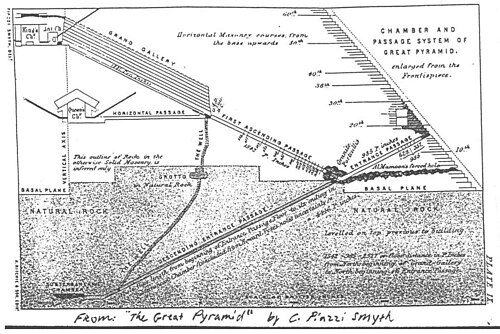Pyramidology
Pyramidology is a term (apparently coined by Martin Gardner[1]) to refer to various pseudoscientific speculations regarding pyramids.
Most of these speculations deal in particular with the Egyptian pyramids, especially the Pyramid of Khufu at Giza. However, "pyramidologists" also concern themselves with the monumental structures of pre-Columbian America (such as such as Teotihuacan the Mesoamerican Maya civilization, and the Inca of the South American Andes), and the temples of Southeast Asia.
The claims of pyramidology are regarded as pseudoscience by the scientific community at large, who regard their hypotheses as sensationalist, inaccurate and wholly deficient in empirical analysis and application of the scientific method. Even so, several writers whose speculative works consist of or use material of this nature have found a receptive audience among some sectors of the general public, and the sales of their books can be substantial.
The main types of pyramidological accounts involve one or more aspects which are :
- pseudoarchaeological: Theories that deny that the pyramids were built to serve as tombs; alternative explanations about the construction of the pyramids (for example the use of anti-gravity technology); and hypotheses that they were built by someone other than the historical Ancient Egyptians (e.g. Atlanteans, extra-terrestrials).
- numerological: Theories that the measurements of the Great Pyramid are esoterically significant, and their geometric measurements contain some encoded message.
- Pyramid power: Claims that pyramids as a geometrical shape contain supernatural powers.
History
Martin Gardner described Pyramidology in 1952, in what may have been the first use of the term:
- "...known as Pyramidology...rivals Atlantis in the number of books devoted to it..."[1]
However, no books before his are known to use the term Pyramidology. Gardner continues:
- "...it was not until 1859 that Pyramidology was born. This was the year that John Taylor, an eccentric partner in a London publishing firm, issued his The Great Pyramid: Why was it Built? And Who Built it? ... Taylor never visited the Pyramid, but the more he studied its structure, the more he became convinced that its architect was not an Egyptian, but an Israelite acting under divine orders. Perhaps it was Noah himself."[1]

John Taylor was also the source of the frequenty claimed appearances of both Pi and the golden ratio in the proportions of the pyramids.
Taylor in turn influenced Charles Piazzi Smyth, who made numerous calculations on the pyramid, and attributed it's construction to the Hebrews (Whom he assimilated to the Hyksos dynasty), under the guidance of Melchizedek.
These theories were then integrated in the works (and prophecies) of Charles Taze Russell, who founded the Bible Student movement (most visible today in the Jehovah's Witnesses, though Russell's successor, Joseph F. Rutherford, denounced pyramidology as unscriptural so that modern Jehovah's Witnesses have little knowledge of Pyramidology).
